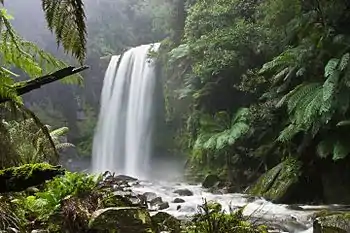Gap analysis (conservation)
Gap analysis is a tool used in wildlife conservation to identify gaps in conservation lands (e.g., protected areas and nature reserves) or other wildlands where significant plant and animal species and their habitat or important ecological features occur.[1]
Conservation managers or scientists can use it as a basis for providing recommendations to improve the representativeness of nature reserves or the effectiveness of protected areas so that these areas provide the best value for conserving biological diversity. With the information that a gap analysis yields, the boundaries of protected areas may be designed to subsume 'gaps' containing significant populations of wildlife species that can enhance the long-term survival of a larger metapopulation of the species already within the managed or protected area, or to include a diversity of wildlife species or ecosystems that merit protection but are inadequately represented in an existing protected area network. Gap assessments can be done using the geographic information system: land maps that delineate topography, biological and geological features (forest cover, plains, rivers, etc.), boundaries, land ownership and use are overlaid with the distribution of wildlife species. How much of the species' distribution fall within or without the conservation lands, or within a highly exploited area etc. can be identified.
At its simplest, a gap analysis is an assessment of the extent to which a protected area system meets protection goals set by a nation or region to represent its biological diversity. Gap analyses can vary from simple exercises based on a spatial comparison of biodiversity with existing protected areas to complex studies that need detailed data gathering and analysis, mapping and use of software decision packages.
Gap types
Gap analyses generally consider a range of different “gaps” in a protected area network: [2][3]
- Representation gaps: either no representations of a particular species or ecosystem in any protected area, or not enough examples of the species or ecosystem represented to ensure long-term protection.
- Ecological gaps: while the species or ecosystem occurs in the protected area system, occurrence is either of inadequate ecological condition, or the protected area(s) fail to address species movements or specific ecological conditions needed for long-term survival or ecosystem functioning.
- Management gaps: protected areas exist but management regimes (management objectives, governance types, or management effectiveness) do not provide full security for particular species or ecosystems given local conditions.
References
- Scott, J.M. and Schipper, J. 2006. Gap analysis: a spatial tool for conservation planning. Pp. 518-519 in M.J. Groom, G.K. Meffe, C. Ronald Carroll and Contributors. Principles of Conservation Biology (3rd ed.). Sunderland, MA: Sinauer.
- Tisdell, C., Wilson, C. and Swarna Nantha, H. 2005. Policies for saving a rare Australian glider: economics and ecology. Biological Conservation 123(2): 237-248.
- Fearnside, P.M. and Ferraz, J. 1995. A conservation gap analysis of Brazil's Amazonian vegetation. Conservation Biology 9(5): 1134-1147.
External links
- Web viewers for various North American gap data sets compiled by the USGS

